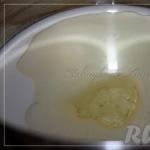The bathroom is a special room in the apartment, which is almost always warm and humid. Such conditions are a favorable environment for the appearance there. It will be quite difficult to get rid of them in the future. Therefore, all cracks and gaps at the joints of surfaces in the bathroom must be sealed during renovation. And for these purposes they are most often used silicone sealant. And in order to do everything carefully, you need to first familiarize yourself with how to use it correctly.
Application of silicone-based sealant
Eat different types sealants, and the most common is silicone. It has excellent properties and is perfect for sealing joints in bathrooms. There are two types: acidic, used only for metals that do not rust, and neutral, used for any surface. It is the neutral sealant that is most often chosen for bathrooms. Among the advantages of silicone sealants are:
- high degree of strength;
- excellent elasticity;
- good resistance to temperature changes;
- excellent water-repellent characteristics;
- long service life.
Attention! The best option for bathrooms there will be silicone sealant labeled “sanitary.” It contains special antibacterial additives that prevent the formation of fungus.
Preparing surfaces for sealant
Using silicone sealant is very easy. But first you need to make preparatory work in the places where it will be used. Surface preparation consists of three stages:

The sealant allows you to reliably seal all joints and seams
- cleaning joints and seams in the bathroom from dirt and dust - you can use a vacuum cleaner for this purpose;
- degreasing surfaces intended for sealing with sealant - to do this, wipe the cleaned seams with acetone or alcohol;
- drying work surface– wipe dry or do this with a hair dryer.
Attention! Careful preparation of the seams in the bathroom for the sealant will ensure its best adhesion to the surface.
How to use sealant
Silicone sealants are sold in standard packaging - tubes. Before you start using the product, you need to prepare it. To do this, cut the tip of the tube at an angle, which makes it easier to apply the silicone, and put on the cap included with the sealant. After this, the prepared tube is inserted into a special gun and fixed in it.
Inserting the tip of the tube with sealant deeper into the seam, apply silicone evenly over the entire surface to be treated. The force of pressing when working with a gun must be compared with the moderation of movement along the gap or joint. This will result in a smooth and beautiful seam. Silicone serves to protect the surface from moisture penetration. Therefore, saving sealant would be inappropriate here. All voids in the seam being processed must be filled. If this is not done, then when the silicone dries, cracks may form between the surface itself at the joint and the sealant.
The seam may not always turn out perfectly straight the first time. There's nothing wrong with that. Before the sealant has time to harden, you can remove its excess and level the seam with a rubber spatula slightly moistened with water, or use a small scraper made from a piece of plastic for this purpose. Many people smooth out the seam simply with their finger when nothing suitable is at hand. But it’s better to at least wet your finger in a soapy solution before doing this.
Advice. In order not to stain the surfaces adjacent to the seam with silicone, it is better to stick mounting tape along it before applying the product as close to the joint as possible and remove it after completing the work.
How long does silicone bathroom sealant take to dry after application?
Drying times for silicone sealants vary from manufacturer to manufacturer. But regardless of its composition, it can dry in different ways. This depends on the type of surface, the thickness of the applied layer, and the temperature in the room. Top layer The sealant stops being sticky after about 20-30 minutes, but it still remains liquid inside.
After a few hours, the silicone hardens and takes about a day to dry completely. For deep and voluminous seams, it may take even more time - up to two days. And all this time it is necessary to protect the composition applied to the seam from moisture that may get on it, that is, it is better not to use the bath.

Applying sealant
How to remove old silicone sealant
Before sealing gaps with sealant during repairs, the seams must be thoroughly cleaned of the old layer of silicone. You can remove it:
- mechanically - sharp knife scrape off the already hardened old layer silicone;
- using special means - sometimes a layer of old sealant cannot be removed with a blade or knife. In this case, special removers and solvents will help remove it.
The best way to dissolve silicone sealant
A small amount of this product can be wiped off with alcohol, gasoline, or white spirit. There are plenty of different solvents on sale that can be used to remove sealant from the surface. But most of them do not completely clean the silicone, but only soften it. But after that it will be much easier to remove it. But it is worth keeping in mind that all of these products may have some restrictions on use on certain types of surfaces. Therefore, you first need to try them in an inconspicuous place.
Silicone-based sealant is a convenient and practical product, and it is quite easy to use. Using it in the bathroom can effectively protect this room from the appearance of traces of mold and mildew.
How to use silicone sealant: video
Silicone sealant: photo



Where is silicone used?
Surface preparation.
Caring for silicone seams.
******************************************************
Different types of silicone and their features.
This article will focus on sanitary silicone sealants.
Silicones are divided into acidic and neutral. Acidic ones have a distinct vinegar smell. Neutral ones have almost no smell.
By operational properties they are almost the same.
There is a much greater difference price categories silicone sealants. As usual, the more expensive, the better.
For wet areas sanitary sealants are produced. They contain bactericidal additives.
Personally, I prefer acid sealants.
Silicones are available in a variety of colors. About colorless ones, I’ll note that there are matte and glossy ones. In certain cases this matters.
For example, when sealing linen winding on water fittings- if you use a glossy sealant, it will always seem like water has come through. Which, of course, will be annoying.
Matte sealant would be just right here.
Where is silicone used?
When renovating an apartment, silicone is used:
- when installing plumbing fixtures;
- for sealing gaps between the window and the window sill, as well as around the perimeter of the window;
- for sealing water fittings;
- for sealing air ducts.
The main mistakes that occur when working with silicone.
- Insufficient preparation of surfaces before silicone application. Simply cleaning surfaces from dirt and dust is not enough. Be sure to degrease the surfaces with a degreaser, acetone, or gasoline. Do not use white spirit, thinner 646, etc. — after their use, an oil film remains on the surface.
- When removing excess silicone, novice specialists feel sorry for throwing away this excess, and they try to somehow use it in further work. This is absolutely impossible to do. Often, you have to throw away more excess than there is useful leftover, but nothing can be done about it, you need to come to terms with it.
- The lifetime of acid silicone is five minutes after application. During this time, you need to have time to remove the excess, otherwise a film will form that will prevent you from doing this.
- The most common mistake is removing excess silicone “dry”. Be sure to spray the silicone with the solution described below before removing it. You can’t just spray it with water - the result will be disastrous.
Tools and materials for working with silicone.
1. Painting knife:
This knife has one secret - a spare blade hidden in the handle.

With a knife you can trim old silicone, clean seams, and open a new silicone cartridge.

Chisel. Used to clean surfaces from coarse contaminants.

Scraper for final cleaning of surfaces.

A stick for removing excess silicone.

A specialized scraper for removing excess silicone. 
Has a built-in blade for cutting the neck of the cartridge.

Curly spatulas for removing excess silicone. The working edge must correspond to the intended width and shape of the seam.


Painting tape for protecting surfaces.

An ice cream stick, sharpened to the desired radius.


Cartridge gun

Brush for spraying soap solution.

Cutter for stripping seams from old silicone.

Toilet paper.

Spray.

Soap or neutral detergent. Fairy or Adj will do. Attention! Do not use alcohol detergents!

It is not necessary to have all these tools; it is enough to choose what is needed for a specific task.
Surface preparation.
Surface preparation consists of cleaning and degreasing. Special attention: Surfaces must be dry!
Clean with a chisel or scraper. Wipe with a rag and degreaser. We wait one minute - you can start applying silicone!
Silicone application technology.
We prepare the tool for work.
We make soapy water by rubbing a bar of soap in water or adding detergent to water. For a liter of water, 1 tablespoon of detergent is enough.
In general, a liter is a lot. In most cases, 200 grams is enough.
Refill the spray bottle. If you don’t have it at hand, you can use a brush or any brush.
We release the roll from the wrapper. We tear off several strips of two squares.
Cut off the tip of the cartridge. We screw the extension spout onto it and make an oblique cut on it.
When applying silicone, it is important to do it in one pass.
In this case, the width of the silicone “sausage” should be greater than the width of the intended seam.
We obtain the required width by cutting off the tip of the cartridge in the appropriate place.
We make the cut obliquely and apply sealant, pressing the cut against the seam.
We insert the cartridge into the gun and do a test squeeze. Sometimes silicone initially produces a colorless liquid, which needs to be removed.
All excess silicone is placed on a sheet toilet paper and wrap themselves in it so that it is impossible to get dirty later.
So, let's start applying silicone to the seam or corner.
Procedure for applying silicone.
For beginners, it is better to apply silicone no more than 1 m at a time. Otherwise, you may not have time to remove the excess.
When applying silicone, you need to take into account that spraying with a soap solution causes this solution to flow down.
Therefore, if you start siliconing a vertical seam, then the lower horizontal seam will then have to be dried.
So it's better to start from the bottom tier and then move up.
It is also useful to start from the corner in both directions at once. Let's say half a meter.
If a vertical seam goes up from the same corner, then in front of the silicone bottom seams You need to stick masking tape onto the section of the vertical seam so that it does not get wet when sprayed with soapy water.
So, we applied silicone to two sections, half a meter from the corner. When applying, it is important to try to fill the gap in the corner as deeply as possible.
This way the silicone will hold on more firmly.
To achieve this, you need to press the cartridge nose with the cut to the corner and when squeezing out, make sure that there are no voids.
The silicone should lie in an approximately even layer, slightly larger than the width of the intended seam.
If there is a mistake somewhere, you can go back and add more silicone.
After application is completed, we shoot the rod with a special button on the gun to stop the movement of the sealant.
The next step is to moisten the scraper with a soap solution, which we will use to remove the excess.
By the way, an ordinary teaspoon works well for this purpose.

If you do not let the silicone dry on it, it will be quite suitable for further use.
When removing excess, you need to make sure that the silicone does not fall from the scraper (spoon).
At this moment, we smoothly tear the scraper away from the seam, lay out the excess on a piece of toilet paper, wipe the scraper until clean, moisten it with the solution and continue removing from where we left off.
If there is excess silicone left on one of the surfaces (beyond the boundary of the resulting seam), then there is no need to worry about it - it can then be removed without problems - with a scraper with a blade.
Here it is important not to get carried away and not to climb onto the unmoistened area of the seam, because you cannot remove the silicone “dry”! — The edges of the silicone will be smeared on the walls and it will be impossible to trim it!
So, the excess has been removed, you can continue applying silicone.
We continue again in both directions in order. If there is another corner ahead, then we start from the corner and approach our stopping place.
If there is a rounding along the way, for example, the edge of a sink, then silicone is applied as usual, and removed with a scraper in a perpendicular position - that is, gradually tilting it, following the radius of the rounding.
In some cases, you can correct the shape of the resulting seam with your finger dipped in soapy water.
When siliconing the sink to the wall, it is important not to “bottom” the seam, so that there is no recess in which water could stagnate.
This can be achieved by removing the excess with an ice cream stick placed horizontally.
By the way, the faucet on the sink can get in the way at this moment, so you need to remove it in advance or use a short stick.
Having finished with the lower tier of horizontal seams, we proceed to the vertical seams.
Removing excess silicone, cleaning surfaces.
Excess silicone remaining on the wall (floor) can be easily cleaned off after drying with a scraper with a blade. Residues are wiped off with a cotton cloth.
If you happen to accidentally drop silicone onto the front surface, you can immediately wipe it off with a rag moistened with a degreaser, or you can wait until it dries and peel it off without any problems.
True, there is a risk of stepping on it and dragging it all over the apartment, so it’s better to use the first option.
How to remove silicone from a seam and clean the surface.
Old silicone from the seam can be removed by cutting it with a sharp knife, separating it from the adjacent surfaces. Clean off the remains with the same knife or a scraper with a blade.
If you have time, you can wet a rag special composition and place on the seam for 24 hours, and then easily remove.
Caring for silicone seams.
The hardening time of the seams varies depending on the thickness of the seam and the humidity in the room.
On average, after two hours you can pour water on the seam, and after a day you can wash it.
If silicone was used to seal the tile joints of a plumbing hatch, then you need to wait three to five days for complete hardening.
Silicone does not require special care; it is enough to wash it with soapy water and non-abrasive sponges or a regular rag.
If blackness begins to appear on the silicone, this means indoors high humidity or in this place the silicone has a hole in which water stagnates.
The fight against blackness comes down to eliminating these causes.
Below is a video showing the silicone of the window sill.
4 comments
-
I tried to work with cosmofen. I wasn't happy with the result. Do you have photo-video good example? And maybe you can share your welding technology?
I agree with the previous statement. The only downside is that cosmofen cannot be replaced like silicone, but at the same time it is not necessary. It does not turn yellow or black. Unfortunately there are no photos either. The principle of operation is approximately the same as with silicone.
Silicone caulk is a thick, viscous substance that is used to fill cracks and cavities to provide a waterproof seal.
To perform this procedure, knowledge of how to use silicone sealant is required. He received wide application in construction, because it is more effective than mastics, bitumen mixtures and putties. Therefore, the sealant is used to treat joints and seams; silicone sealant protects not only from moisture, but also from the destructive effects of the environment.
The basis of the sealant is a silicon-based polymer, and silicone is produced from the polymer. Source material defines technical specifications seal:
- Elasticity. Due to this, the scope of application of silicone extends to movable joints. Using a sealant, deformation at the joints is compensated. At the same time, the material is resistant to temperature and mechanical influences.
- Good adhesion to surfaces (ceramic, glass, metal, wood, concrete, plastic, etc.)
- Resistance to external natural factors. The sealant is suitable for use not only indoors, but also outdoors. The material is not affected by ultraviolet radiation, detergents, changes in temperature and humidity. Mold and fungal bacteria do not form on silicone sealant.
- Strength. Material resistance to stretching.
- Wide temperature range, in which silicone can be used. Minimum value for a high-quality seal it is -50°C, maximum +200°C. There are special types of sealants whose upper temperature limit is increased.
To better understand what silicone sealant is, you need to familiarize yourself with its composition. The following substances are used in production:
- silicone rubber;
- reinforcing element that gives the necessary strength;
- filler to create the desired volume and color;
- substance to increase plasticity;
- vulcanizer to impart viscosity;
- material that enhances the adhesion of silicone to the surface.
There are several types of vulcanizers that are added to silicone. Depending on this, there are different types of sealants:
- Acid. It has a characteristic vinegary odor. This sealant is not used for working with aluminum, marble, cement-containing materials, because they are sensitive to acetic acid.
- Neutral. Can be used to work with any materials.
The properties of silicone sealant are influenced by the additives used in production. We list the most common of them:
- Dyes. Due to this, the dried sealant does not change color.
- Mechanical. Strengthens the adhesion of silicone to the surface.
- Natural components that reduce the viscosity of the sealant.
- Chemicals that destroy mold and mildew.
Classification of silicone sealants by purpose
Depending on the scope of application, different types of silicone sealants are used:
- sanitary;
- high temperature;
- glass;
- universal;
- sanitary neutral;
- neutral for working with stone;
- building neutral;
- neutral for mirrors;
- roofing;
Let's describe each of them in more detail.
- Sanitary. Belongs to the group of acidic sealants, resistant to moisture, the formation of fungi and mold. This factor determines its use in the kitchen, bathroom, and laundry room. Sanitary silicone adheres well to glass, ceramics, enamel surfaces, concrete, brick, wood and some metals. Using this sealant, cracks near the toilet and spaces between the wall and the sink are strengthened; joints on the wall, washbasin, bathtub, trays. Cannot be used on Teflon and natural stone surfaces.
- High temperature. Resistant to high temperatures (up to +285°C). Adheses well to glass, metal and ceramic surfaces. Fuel, lubricants and oils do not destroy it. For these reasons it is used in heating systems, air conditioners, kitchen equipment and motors.
- Glass. Has good adhesion to smooth and porous surfaces. Not susceptible to UV radiation, tolerates low and high temperatures. The described type of silicone is used for glass elements, ceramic tiles, wood, brick. It cannot be used if acrylic surfaces and polyvinyl chloride are present.
- A universal silicone sealant is used for porous materials, ceramics, glass, and some metals. It is unacceptable to use a universal sealant on surfaces that are susceptible to corrosion, such as polyvinyl chloride and acrylic.
- Sanitary neutral. Not susceptible to external irritants. Building materials are treated with a sanitary neutral sealant. It is not permissible to use in rooms with high humidity.
- Neutral for working with stone. Insensitive to UV radiation. Tolerates weather conditions well. Neutral silicone is applied to natural stone, glass, polyvinyl chloride and acrylic surfaces.
- Construction neutral. Does not lead to discoloration of materials. It is used indoors and outdoors, when creating fixed joints. Has good adhesion to building materials.
- Neutral for mirrors. With its help, dimensional mirror structures are created and the seams between the mirrors are filled.
- Roofing. Used for construction and repair work on the roof. Roofing sealant slow-moving elastic joints of tiles are processed, skylights, chimneys. Immune to changes in weather conditions.
There are two types of silicone seals:
- one-component;
- two-component.
The first are intended for private and mass construction and repair. This is due to the ease of use of the sealant. It can be applied immediately. Hardening occurs upon contact with air. Before using a two-component sealant, the substances must be mixed. It also hardens when mixed. Therefore, this material is used only in industry.
Selecting silicone sealants by color
To choose the right color for silicone sealant, you need to know what it will be used for.
- The colorless sealant is considered universal. There are no restrictions on its use.
- White. Designed for working with balconies and plastic windows.
- Black. Used in cars.
- Color. There is a wide range of shades. This silicone is convenient when working with building materials.
Where are silicone sealants used?
The areas of application of silicone can be divided into three groups:
- external works;
- interior works;
- work in rooms with high humidity.
External works include those associated with drainpipes, window frames and frames, glass structures, stone tiles, roofing. Internal works are considered:
- sealant treatment of parts that heat up to high temperatures;
- applying silicone to seams, cracks in the window sill;
- sealing the joint between the ceiling and plasterboard.
In rooms with high humidity, silicone sealant is applied to the connecting areas sewer pipes, at the junction of the shower stall and the wall. When installing mirrors, silicone is also used.
Advantages and disadvantages of silicone sealants
Advantages of the seal:
- elasticity;
- good adhesion to many materials;
- strength;
- durability;
- resistance to ultraviolet rays;
- moisture insulation;
- good tolerance to temperature changes;
- resistance to aggressive environments;
- ease of operation;
- low price.
The disadvantages of the sealant are that it is not intended for application to wet surface, does not adhere well to plastic, hardens for a long time at high humidity and low temperatures. If silicone does not contain impurities and additives, then it cannot be painted.
Sealant consumption
Silicone calculations are made per 1 m of joint, crack, seam. To do this, you will need to find out the width and depth of the opening that will be filled. Then the width is multiplied by the depth, and the resulting number shows how much silicone will be used per 1 m hole. This value is multiplied by the length of the opening to find out how much sealant will be used. If the seam is triangular, the resulting number will need to be divided by 2. If a gun is used, then the costs of the sealant are reduced, because all the silicone is completely squeezed out of the tube.

The width and depth of standard seams is 6 mm. If the specified parameters exceed this value, then the use of a special silicone cord, which will act as a seal. The thickness of the joints is determined when drawing up the building design. The standard thickness is less than 7 mm. For cases where seams are processed in wooden houses, you will need to determine the width, height and length of the opening. To calculate the height, the thickness of the log is divided by 10, and for further calculations a slightly smaller number is taken.
Review of manufacturers: which one is better to choose
The company Macroflex (France) has been producing adhesive compositions. Silicones of this brand are of excellent quality and have high performance characteristics. A reliable and universal sealant will cost a little less. Russian company Moment. In terms of quality, it is almost as good as French. For the production of silicone from Econ (Russia), Henkel equipment is used. Besides, foreign company controls production process. Low price, ease of use - additional benefits sealant Econ.
The Polish company Selena produces professional silicone. The company produces construction chemicals. Ceresit (Germany) occupies a leading position among manufacturers of building materials. The company has existed for 100 years, so it offers wide range silicone sealants.
Speed up the drying of the sealant
In order for the silicone to harden as quickly as possible, it is necessary to correctly apply the silicone to the surface. First, the spout on the tube is cut off. Then the nozzle is put on, which appearance resembles a syringe. The nozzle hole is designed for narrow seams. To increase the seam, the tip is cut at an angle of 30 - 45º. Then the tube is placed in the gun, the silicone is squeezed out to the spout. There is a small lever behind the gun that must be pressed to release the pressure.
The surface intended for applying the material must be cleaned and dried in advance. After this, you can squeeze the seal into the hole. Processing begins from the edge, bringing the gun closer to you at an angle. Then you need to smooth out the resulting seam.
To quickly dry silicone sealant, you need to set the room temperature to +22… +25ºС and increase the air exchange rate. Strong heat will not speed up the drying of silicone sealant. Air humidity also affects curing time. The drying speed also depends on the manufacturer and on chemical composition silicone. If the seam is thick, it will be necessary to apply silicone sealant in several layers.
How to clean and remove silicone sealant without damaging the surface
To remove silicone sealant, it must first be softened with a solvent. Concentrated vinegar is suitable for an acid sealant. Alcohol sealants can be removed using alcohol. Neutral silicones are dissolved with acetone and gasoline. Eat universal remedy, which is suitable for removing any silicone, is Antisil. Then you will need to wash out any remaining stains from the sealant.
How to remove old sealant and apply a new one
Removing the old layer of sealant
For good waterproofing of the space between plumbing equipment And tiled wall use . It is extremely difficult to regularly replace the layer of sealant with a new one, since it sticks tightly to the surface, but a special solvent can help you. However, try to initially choose a high-quality sealant for wet rooms and carefully apply it to the required joint.
Most affordable way, which can be used to remove sealant without leaving home to purchase special equipment -mechanical impact, that is, simply put, try to carefully cut off the old sealant by scraping, using a knife, scraper or spatula. The main thing here is not to overdo it, so as not to damage the work surface.

Special knife - scraper for removing sealant
If you completely wipe off the sealant mechanically fails, then applyspecial means for removing traces of old sealant (chemical exposure), they can also be used to soften rather thick or well-adhesive sealants that need to be washed.

We can recommend such well-knownsilicone sealant removerssuch as: Silicon-Entferner, Sili-Kill and Soudal Sealant Remove, they allow you to soften and remove old silicone applied to ceramic, enamel or plastic. But acrylic and polyurethane sealants can only be removed mechanically.
If you need to remove the old layer of sealant and apply a new one, use these tips.
 |
1. Using a knife, remove the old sealant. Trim it on one side first. |
 |
2. Then cut the sealant on the other side and remove the sealant thread. |
 |
3. As a rule, it is not possible to cut the sealant cleanly. To remove residual sealant, moisten it with solvent. |
 |
4. Leave the solvent for about 30 minutes. |
 |
5. After this, scrape off the remnants of the already softened sealant. |
 |
6. Rinse the joint thoroughly with water and wipe with a dry cloth. |
Applying a new layer of sealant
The compounds can be applied to a degreased (just wipe the surface with alcohol) and dried surface (a hairdryer will help you here). new layer sealant. Use a special sealant for plumbing fixtures, preferably a fungicidal one, to avoid mold.
 |
1. Carefully cut off the tip of the canister containing the new sealant. |
 |
2. Insert the sealant bottle into a special mounting gun. |
 |
3. Carefully, in an even layer, apply a thin layer of sealant to the joint. |
 |
4. Release the pressure on the gun by pressing the lever on the back of the gun - this will stop the pressure of the piston on the bottom of the bottle and the flow of sealant will be interrupted. |
 |
5. Wet your finger with dishwashing liquid. |
 |
6. Apply this liquid to the sealant with your finger. |
As a rule, the sealant is applied using a balloon and mounting gun, but special small tube-syringes are much easier to use.
 |
1. The sealant can be easily applied using a special device in the form of a syringe. |
 |
2. Insert the plunger into the syringe tube. |
| 3. Carefully apply and spread the sealant at the same time. | |
 |
4. Another version of the sealant applicator consists of a reservoir in which the sealant is pressurized, and a tip that allows you to regulate the flow of sealant. |
In the bathroom, all surfaces are exposed to a damp environment and frequent changes temperatures Therefore, it is very important to seal not only the seams between the tiles, but also the joints at the border of the wall and the bathtub, washbasin or other surfaces. Silicone sealant is perfect for this.
Key Benefits
In order to make pipe joints between the wall and the bathtub, sealant must be used. Assortment building materials offers several options based on different polymers. Suitable for use in bathrooms:
- Silicone.
- Acrylic.
- Silicone-acrylic.
- Polyurethane.
Silicone based sealant is the most suitable option, which will help firmly bond the surfaces. It is different:
- Resistant to temperature changes. Manufacturers indicate the boundaries within which the substance fully retains its properties, this is from -50 to + 200 degrees Celsius.
- Excellent adhesion. It adheres well to all materials used to furnish a bathroom (tile, metal, acrylic, wood, glass).
- Duration of operation.
Silicone-based sealant has excellent adhesion and resistance to temperature differences
But you need to remember that such sealant is more expensive than others. Although you shouldn’t skimp on creating a safe bathroom.
How to choose the right option
- Moment.
- Penosil.
- Tytan.
- Ceresit.
These manufacturers offer packages of different sizes. In addition, a coloring agent is added to the main composition, which allows you to select a sealing material that is invisible on any surface.
Advice! For home work, it is better to buy 2-3 small tubes of sealant than 1 large one. In a large open container, the substance quickly becomes unusable.
Some options have additional components that help resist silicone sealant to various microorganisms and fungi. Such compositions are called sanitary sealants. They are best used in rooms with high humidity.
When choosing, you must also remember that the composition can be:
- Acidic - acetic acid is added to the composition, because the substance has a pungent and unpleasant odor. This sealant cannot be used for metal surfaces, because they are exposed to acid and quickly rust. The putty is suitable for working with wooden and ceramic surfaces.
- Neutral. This option is universal and does not harm any known substances.
Attention! Additional components in the composition should be less than 10%. Greater value deteriorates the properties of the sealant.

There is currently a wide range of different sealants on the market.
Rules for working with sealant
Buying a quality product is only half the battle. It is also important to use it correctly to get the desired result. Therefore, when working with silicone compounds, you need to consider the following subtleties:
- The composition is applied only to a dry and clean surface. This means that you need to carefully prepare the place where the substance will be applied. The base is washed, dried and degreased with alcohol or acetone.
- After drying, silicone sealant is difficult to remove from surfaces, so the borders must be covered with masking tape. The more carefully the stripes are glued, the more inconspicuously the putty will be applied.
- You need to squeeze the substance out of the tube evenly, without making any gaps.
- Before the composition hardens, you need to level the applied layer. To do this, use a soft spatula or cloth soaked in water and wrapped around your finger in one layer.
Attention! The tool should only be used in the direction in which the sealant was applied. Otherwise, unevenness will form.
- The masking tape is removed before the sealant hardens. Once the substance hardens, it will be difficult to tear it off total mass. Then you will have to trim, and this may lead to a violation of the tightness.
- Hardening time and complete drying time are completely different indicators. The hardening time is about 30 minutes, after which the substance dries and stops sticking to the fingers, complete hardening takes from 6 to 24 hours (depending on the thickness of the layer, temperature and humidity), the period of time after which the sealant acquires all its properties.

Using sealant is not particularly difficult even for a non-professional
Resealing
It often happens that the applied layer becomes unusable due to various reasons(covered with fungus, peeled off due to improper application). You can find many photos on the Internet showing this problem. Then the procedure must be repeated again.
But now you need not only to carefully prepare the base, but also to remove the old layer. This will not be so easy, since, as stated above, silicone sealant adheres strongly to materials.
The putty can be cut off. To do this, choose a knife with a thin and sharp blade or a special construction knife. The remains are cut off carefully and very carefully. Please note that you cannot leave even a small piece, otherwise the new layer simply will not be able to perform its functions.
To remove absolutely all the sealant, you need to use a special softener, which is applied 2 times thicker than the rest of the sealant. After the procedure, everything is removed with a cloth. Next you need to apply silicone sealant after degreasing the surface.
In order to understand in more detail the instructions for applying the sealant, you can watch the video.
Video: Silicone sealant

















